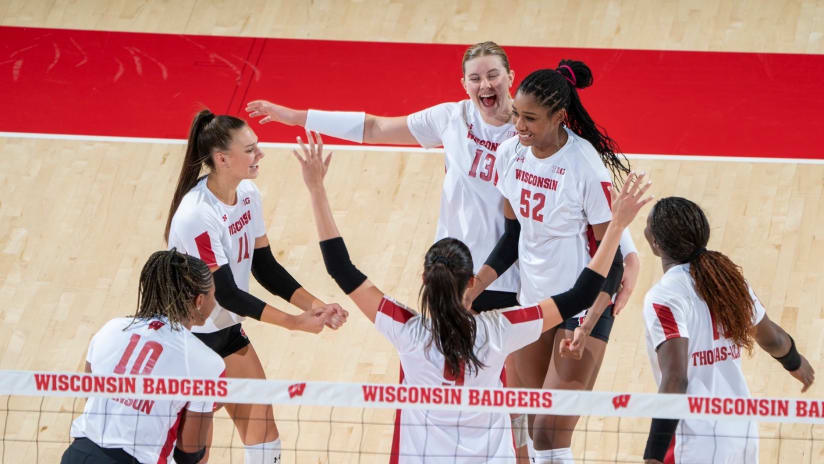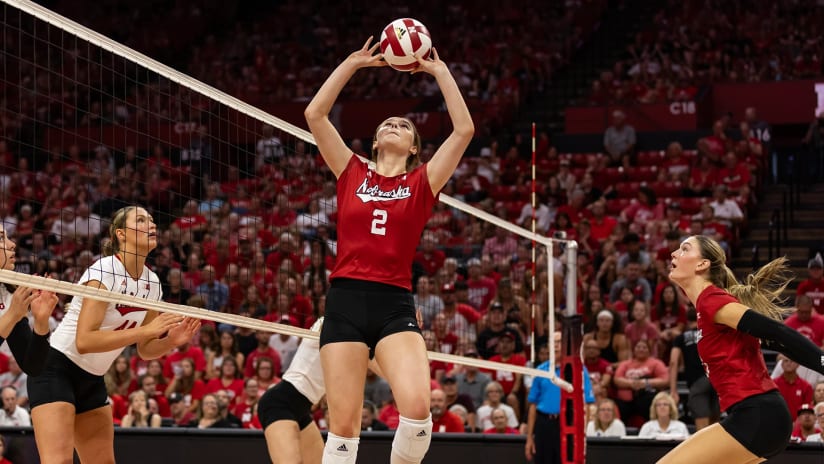For a second straight year, Big Ten matches will be streamed live on VBTV from August to November. Coverage begins with select non-conference matches on August 25 and continues with the start of conference matches on September 22 until the conclusion of the schedule, on November 25.
Big Ten 2023
What is Big Ten volleyball?
Here’s all you need to know about competition in the most prestigious NCAA conference
Published 03:25, 24 Aug 2023

Wisconsin are among the most successful Big Ten programs
- Watch the Big Ten Volleyball matches live on VBTV.
Here’s all you need to know about it:
What is the Big Ten?
The Big Ten is one of 32 NCAA conferences. The NCAA (or National Collegiate Athletic Association) manages sports competitions across colleges and universities in the United States and Canada, involving more than 500,000 students.
Founded in 1896, the Big Ten is the oldest Division I athletic conference in the United States, predating even the NCAA itself, and features competition in 28 different sports. The conference currently includes 14 members and two associate members (with four more members set to join in 2024). The members are located in as many as 11 American states.
How does the NCAA work?
Over 1,200 colleges are affiliated with the NCAA (across all sports). And over 1,000 of those schools feature women’s volleyball programs. They are split into three divisions, according to the size of the institutions, the level of competition and the funding of their athletic programs.
The Big Ten is part of Division I, which is the most competitive. Division 1 features 340 schools across a total of 32 conferences, including: America East, American Athletic, Atlantic Coast, Atlantic 10, Atlantic Sun, Big East, Big Sky, Big South, Big Ten, Big 12, Big West, Colonial, Conference USA, Horizon, Ivy, MAC, MAAC, MEAC, Missouri Valley, Mountain West, Northeast, Ohio Valley, Pac-12, Patriot, SEC, SoCon, Southland, SWAC, Summit, Sun Belt, WAC and West Coast.
Each year, the NCAA organizes a National Championship for each of its three divisions. In Division I volleyball, the 32 conference winners participate in the National Championship. An additional 32 teams are selected to participate by the Division I Women’s Volleyball Committee. Typically, the teams included have enjoyed strong performances across the whole season and feature some of the top players across all conferences.
The National Championship is played in a single elimination format, with the first, second, third and quarterfinal rounds taking place before the Final Four. This year, the top four teams will compete in Tampa, Florida, from December 14-17.
What is the collegiate volleyball season like?
The volleyball season typically starts at the end of August with non-conference matches. This year, the Big Ten Conference regular season begins on September 22 and ends on November 25. In the Big Ten, each team will play a 20-match conference schedule, facing seven schools home and away and the six remaining rivals once.
Before and during the conference season, teams can use available dates to play matches against schools from other conferences (non-conference matches) or tournaments. The results of these matches do not count for their conference standings but are taken into consideration for their season totals. Often, teams book non-conference matches against strong opponents hoping that a good performance will make a positive impression on the Division I Women’s Volleyball Committee and lead to selection for the National Championship.
Which teams are part of the Big Ten?
These are the 14 schools that are members of the Big Ten women’s volleyball program:
· Indiana University (Bloomington, Indiana)
· Michigan State University (East Lansing, Michigan)
· Northwestern University (Evanston, Illinois)
· Pennsylvania ‘Penn’ State University (University Park, Pennsylvania)
· Purdue University (West Lafayette, Indiana)
· Rutgers University (New Brunswick-Piscataway, New Jersey)
· The Ohio State University (Columbus, Ohio)
· University of Illinois (Urbana-Champaign, Illinois)
· University of Iowa (Iowa City, Iowa)
· University of Maryland (College Park, Maryland)
· University of Michigan (Ann Harbor, Michigan)
· University of Minnesota (Minneapolis-St. Paul, Minnesota)
· University of Nebraska (Lincoln, Nebraska)
· University of Wisconsin (Madison, Wisconsin)
Associate members John Hopkins University (Baltimore, Maryland) and University of Notre Dame (Notre Dame, Indiana) only compete in the Big Ten with their men’s and women’s lacrosse and men’s ice hockey teams respectively, while their volleyball programs remain in their original conferences.
Are Big Ten teams among the best in the country?
Yes, Big Ten teams have won eight of the last 15 National Championships and the conference had at least one team in the final as many as 11 times in that same period.
Since the National Championship was first played, in 1981, Big Ten teams have won the title 13 times. Penn State lead the way with seven (1999, 2007, 2008, 2009, 2010, 2013 and 2014), followed by Nebraska with five (1995, 2000, 2006, 2015 and 2017) and Wisconsin with one (2021). Penn State are also the only team to have won four titles in a row.
The conference is expected to become even more competitive in 2024, when the University of California – Los Angeles (UCLA) and the University of Southern California (USC), which have four and three national titles respectively, will leave the Pac-12 Conference to join the Big Ten alongside the University of Oregon and the University of Washington.
Which popular players started their careers in the Big Ten?
Many. From the 12 players that helped the United States win gold at the Tokyo Olympics, in 2021, nine played in the Big Ten Conference. They include setters Micha Hancock (Penn State) and Jordyn Poulter (Illinois), opposite Annie Drews (Purdue), outside hitters Jordan Larson (Nebraska), Michelle Bartsch-Hackley (Illinois) and Kelsey Robinson (Nebraska), middle blocker Haleigh Washington (Penn State) and libero Justine Wong-Orantes (Nebraska).
Other globally-known players who competed in the Big Ten include beach volleyball world champion Sarah Pavan (Nebraska), beach and indoor Olympian Nicole Branagh (Minnesota), former USA national team members Lindsey Berg, Lauren Gibbemeyer (Minnesota), Alissa Glass, Megan Hodge, Nicole Fawcett and Christa Harmotto (Penn State) and current USA team members Ashley Evans, Danielle Cuttino (Purdue), Ali Frantti (Penn State), Lauren Carlini and Dana Rettke (Wisconsin).
Are the rules the same as in international volleyball?
For the most part. One of the main differences is that instead of six substitutions per set, coaches can make 12. And a player can also enter and exit the match multiple times in each set. Another specific rule is the one that allows liberos to serve – they can do so in place of just one of the players they replace, if they replace multiple athletes.
Quick links:
Big Ten Volleyball
VBTV
Facebook
Twitter
Instagram
YouTube
Subscribe to Volleyball World's Newsletter





